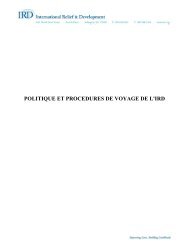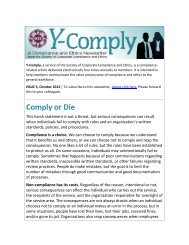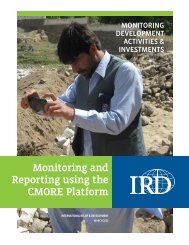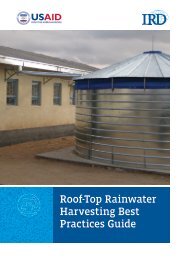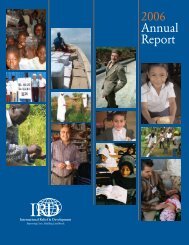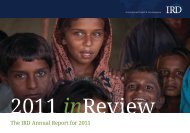Empowering citizens Engaging governments Rebuilding communities
Empowering citizens Engaging governments Rebuilding communities
Empowering citizens Engaging governments Rebuilding communities
You also want an ePaper? Increase the reach of your titles
YUMPU automatically turns print PDFs into web optimized ePapers that Google loves.
“<br />
A cash-for-work jobs program gives<br />
people something productive to do<br />
other than plant IEDs, and it also gives<br />
some sense of hope for the future”<br />
—James Kunder<br />
and essential services work, which required unskilled<br />
labor on quick-impact projects such as trash collection<br />
and rubble removal. CSP supported scores of<br />
these quick-impact projects during the program’s<br />
first year. By the middle of the second year, however,<br />
IRD began to transfer oversight of those projects<br />
back to municipal <strong>governments</strong>. If local <strong>governments</strong><br />
were willing to support the continuation of some of<br />
these services, IRD would continue its involvement<br />
in cleanup activities on a limited basis. But the lack<br />
of concern or unwillingness of many municipalities to<br />
devote resources to basic services like timely trash<br />
removal beyond IRD’s work worsened public opinion<br />
in many cities. Still, the short lead time needed to<br />
initiate service projects allowed cleanup and rubble<br />
removal to serve as a kind of spearhead for CSP as it<br />
expanded. “The trash pickup campaigns were critical<br />
for establishing CSP, not just because they were cleaning<br />
the streets but because they were labor-intensive<br />
projects that covered entire neighborhoods,” said Alaa<br />
Ismael, the head of program management for CIES<br />
activities. “I have no doubt the cleanup activities were<br />
needed for the stabilization program to work in Iraq.”<br />
In Ramadi, as previously noted, IRD launched a<br />
large-scale cleanup program directly on the heels of<br />
military action to remove insurgents. The goal was<br />
not only to provide immediate employment but also<br />
to restore frayed relations between local community<br />
leaders, tribal leaders, and the citizenry. The cleaning<br />
campaign was implemented through a local contractor<br />
responsible for providing laborers with equipment,<br />
organizing debris removal, and paying daily wages. For<br />
the Ramadi cleaning campaign, laborers earned $10 a<br />
day, which was the standard payment for CSP cleaning<br />
campaigns.<br />
Throughout Iraq, approximately 1,600 CIES projects<br />
generated more than 525,000 person-months of<br />
short-term employment—20 percent above the target.<br />
Given the high value placed on providing some kind<br />
of job to as many Iraqi men as possible, as fast as<br />
possible, “person-months employment” was a critical<br />
indicator of immediate impact. By this calculation,<br />
CSP exceeded its target in every year of operation. In<br />
addition, IRD found a great deal of qualitative evidence<br />
from interviews with local beneficiaries, media<br />
coverage, staff assessments, and final reports that<br />
the increase in short-term employment helped reduce<br />
violent incidents in some of the most unstable areas,<br />
such as Howija in Kirkuk.<br />
“The early projects had a rapid, highly visible, and<br />
tangible impact greatly appreciated by the local<br />
government,” said Alice Willard, formerly a senior<br />
monitoring and evaluation officer with IRD. “The same<br />
programs helped validate CSP to local authorities and<br />
opened the door to more diversified collaboration in<br />
a short amount of time.” That collaboration helped<br />
lead to widespread infrastructure rehabilitation, which,<br />
in contrast to essential service projects, relied on<br />
semiskilled and skilled laborers to help with rebuilding<br />
and construction projects relevant to local <strong>citizens</strong>,<br />
such as school restoration, hospital and health clinic<br />
refurbishment, irrigation canal restoration for agribusiness,<br />
and the rebuilding or enhancing of electricity,<br />
sewage, and water delivery services. These projects<br />
were undertaken with joint input from local community<br />
leaders, US military personnel, and PRTs. As IRD transitioned<br />
cleanup campaigns to local municipalities in<br />
the program’s second year, the focus of CIES component<br />
work shifted primarily to infrastructure projects.<br />
In many instances, a single project encompassed both<br />
the cleanup and rehabilitation phases of CIES. One<br />
example is the Mosul Social Club for Families. Before<br />
the war, the club was a popular gathering spot for<br />
dining, entertainment, and community celebrations—<br />
with on average more than 340 events a year. But as<br />
insurgent violence swallowed up Mosul, public socialization<br />
became too risky for most, and the number of club<br />
events plummeted to a few dozen. Before long, a lack of<br />
3<br />
Successes and setbacks<br />
37


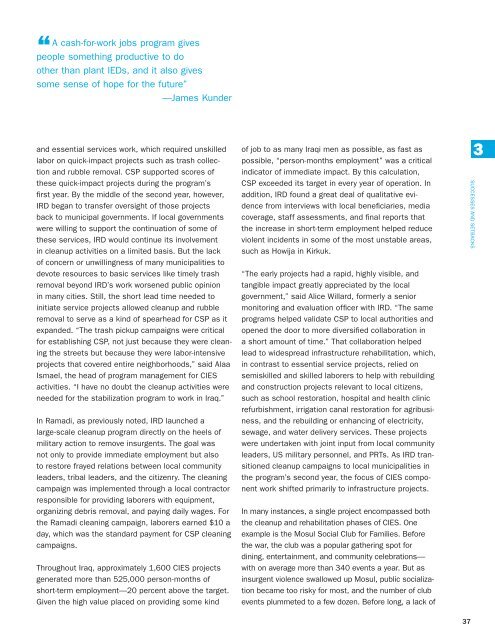
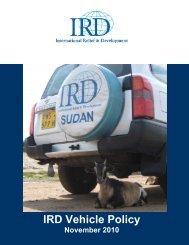
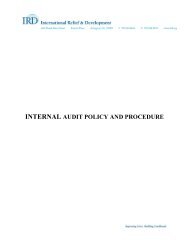
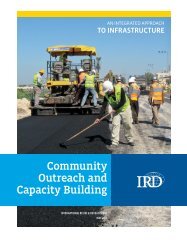
![Guide bonne pratique production d'oignon qualité_VF_4_2411012[1]](https://img.yumpu.com/23506639/1/184x260/guide-bonne-pratique-production-doignon-qualitac-vf-4-24110121.jpg?quality=85)
